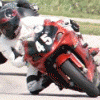Put your math hats on, kids, we're gonna play nerd... In layman's terms, this whole thing is all just a clusterfuck of cross-products, but it's that multi-vector gangbang that makes the bike lean over when you countersteer. Think about however is best for you, but realize that it's the cross-products of angular momentum that is doing all the work here. For simplicity's sake, let's ignore the engine effects, and concentrate on the front wheel.... Here's the big picture of why this works: Now, all this is saying is that the wheel's spin about the z-axis is directly related to its moments about the other two axes as well (nutation and precession). In this plot, the spin would make the wheel precess about the y axis. In a motorcycle, there are two front forks, so there is a shaft on both sides (modeled here as R), thereby making a system with zero precession when spinning with no other inputs. Now here's the important part - since the cross-products are always related, if you introduce precession (by turning the handlebars), you must also introduce nutation along the x-axis. The wheel will want to fall over to the side. This moment will be induced along the center of mass, but since the bottom of the wheel has a tire on it with a lot of friction, it just tips the whole thing over, along with the bike and rider that are attached to it. It's really not that crazy, it's just that people don't normally come across this kind of stuff in everyday conversation, so most people don't get a real explanation of it, so sometimes it can be made out to seem more complicated than it is. Hope that helps, and any of my fellow engineers can chime in a correct me if I've used improper nomenclature







